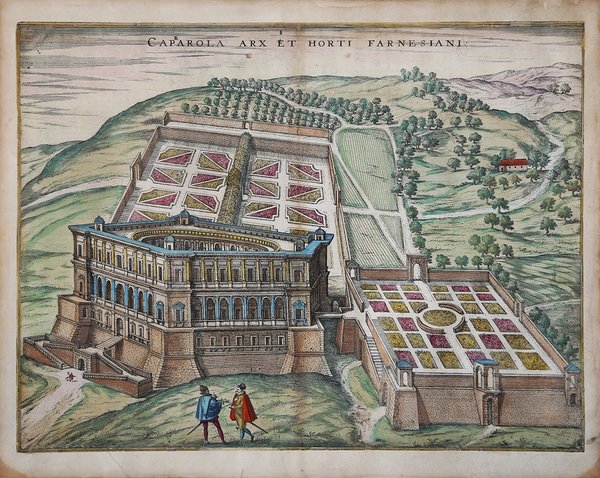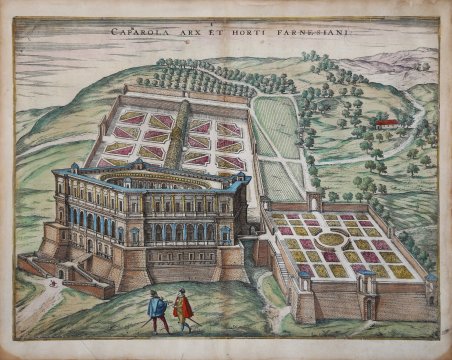Veduta inserita nel quinto volume del ' Civitates Orbis Terrarum, il primo atlante devoto esclusivamente alle piante e vedute delle principali città del mondo, stampato in sei volumi tra il 1572 ed il 1617, ebbe grande fortuna e diffusione, tanto che ne furono stampate diverse edizioni tradotte in latino, tedesco e francese. Il magnifico palazzo di Caprarola, disposto a forma di pentagono sul Monte Cimino, fu commissionato dal cardinale Alessandro Farnese - nipote del notoriamente nepotista Papa Paolo III - all'architetto bolognese Giacomo Barozzi da Vignola nel 1559. Il palazzo di Caprarola, noto anche come Villa Farnese, è visto in prospettiva cavalleresca, lasciando intravedere parzialmente il cortile interno circolare del massiccio complesso pentagonale. All'interno del cortile si trovano splendidi colonnati, all'interno dei quali nicchie a colonne ospitano i busti degli imperatori romani. Nell'incisione si possono ammirare anche i magnifici giardini. L'imponente Villa Farnese è considerata uno dei migliori esempi di architettura rinascimentale. L'edificio, che domina la campagna circostante, si caratterizza per le sue proporzioni rigorose e per la parsimonia degli ornamenti. Dopo la morte di Farnese (1589) la villa passò ai duchi di Parma e fu poco utilizzata. ' (Taschen). Il primo volume delle ' Civitates Orbis Terrarum ' fu pubblicato a Colonia nel 1572. Il sesto e ultimo volume apparve nel 1617. Questo grande atlante di città – cartografia urbana - curato da Georg Braun e inciso in gran parte da Franz Hogenberg, conteneva 546 prospettive, vedute a volo d'uccello e vedute cartografiche di città di tutto il mondo. Franz Hogenberg realizzò le tavole dei primi quattro volumi e Simon van den Neuwel (Novellanus, attivo dal 1580) quelle dei volumi V e VI. Georg Braun (1541-1622), un ecclesiastico di Colonia, fu il principale redattore dell'opera e fu molto aiutato nel suo progetto dalla vicinanza e dal continuo interesse di Abraham Ortelius, il cui ' Theatrum Orbis Terrarum ' del 1570 fu, come raccolta sistematica e completa di mappe di stile uniforme, il primo vero atlante. Le ' Civitates, ' in effetti, erano destinate ad accompagnare il ' Theatrum, ' come indicato dalla somiglianza dei titoli e dai riferimenti contemporanei sulla natura complementare delle due opere. Tuttavia, le ' Civitates ' erano progettate per avere un approccio più popolare, senza dubbio perché la novità di una raccolta di piante e vedute di città rappresentava un'impresa commerciale più rischiosa di un atlante mondiale, per il quale c'erano stati diversi precedenti di successo. Franz Hogenberg (1535-1590) era figlio di un incisore di Monaco che si era stabilito a Malines. Incise la maggior parte delle tavole del ' Theatrum ' di Ortelius e la maggior parte di quelle delle ' Civitates, e potrebbe essere anche indicato come il responsabile dell'origine del progetto. Oltre un centinaio di artisti e cartografi diversi, il più importante dei quali fu l'artista di Anversa Georg Hoefnagel (1542-1600), fornirono i disegni per le tavole delle ' Civitates. Hoefnagel non solo contribuì alla maggior parte del materiale originale per le città spagnole e italiane, ma rielaborò e modificò anche quello di altri collaboratori. Dopo la morte di Hoefnagel, il figlio Jakob continuò il lavoro per le ' Civitates. Gli autori della raccolta si proponevano di raffigurare "non icones et typi urbium", cioè non immagini generiche e tipizzate, "sed urbes ipsae admirabili caelaturae artificio, spectantium oculis subiectae appareant": non intendeva alludere o idealizzare, ma rappresentare fedelmente sulla carta, riprodurre esattamente, e in tempo reale, ciò che l'occhio vede, come annunciato nella prefazione al primo volume delle ' Civitates Orbis Terrarum. Incisione in rame, coloritura coeva, restauro ai margini, per il resto in ottimo stato di conservazione. ' A view of Caprarola (Latium) and the Farnese Palace, by Braun and Hogenberg. "The magnificent palace of Caprarola, which is laid out in the shape of a pentagon on Monte Cimini, today lies in the Lago di Vico nature reserve. It was commissioned by Cardinal Alessandro Farnese - grandson of the notoriously nepotistic Pope Paul III - from the Bolognese architect Giacomo Barozzi da Vignola in 1559. Caprarola palace, also known as the Villa Farnese, is seen in cavalier perspective, allowing the viewer a partial glimpse into the circular inner courtyard of the massive pentagonal complex. Inside the courtyard are splendid colonnades, within which columned niches house the busts of Roman emperors. The magnificent gardens can also be admired in the engraving. The massive Villa Farnese is considered one of the finest examples of Renaissance architecture. The building, which dominates the surrounding countryside, is characterized by its strict proportions and sparing ornamentation. After Farnese's death (1589) the villa passed to the Dukes of Parma and received little use. In the 19th century the villa served for a while as the residence of the heir to the throne of the Kingdom of Italy; today it is the occasional home of the Italian president. In 1580 Montaigne praised the building as the most beautiful palace in Italy, a compliment that probably inspired Braun and Hogenberg to include it in their city atlas". (Taschen). The work is included in the ' Civitates Orbis Terrarum, the first atlas devoted exclusively to plans and views of the world's major cities. Printed in six volumes between 1572 and 1617 it was so successful and widespread that several editions translated into Latin, German and French were printed. The first volume of the ' Civitates Orbis Terrarum ' was published in Cologne in 1572. The sixth and the final volume appeared in 1617. This great city atlas, edited by Georg Braun and largely engraved by Franz Hogenberg, eventually contained 546 prospects, bird-eye views and map views of cities from all over the world. Fransz Hogenberg produced the plates for the first four books, and Simon van den Neuwel (Novellanus, active since 1580) those for volumes V and VI. Georg Braun (1541-1622), a cleric of Cologne, was the principal editor of the work, and was greatly assisted in his project by the close, and continued interest of Abraham Ortelius, whose ' Theatrum Orbis Terrarum ' of 1570 was, as a systematic and comprehensive collection of maps of uniform style, the first true atlas. The ' Civitates, ' indeed, was intended as a companion for the ' Theatrum, ' as indicated by the similarity in the titles and by contemporary references regarding the complementary nature of two works. Nevertheless, the ' Civitates ' was designs to be more popular in approach, no doubt because the novelty of a collection of city plans and views represented a more hazardous commercial undertaking than a world atlas, for which there had been a number of successful precedents. Franz Hogenberg (1535-1590) was the son of a Munich engraves who settled in Malines. He engraved most of the plates for Ortelius's ' Theatrum ' and the majority of those in the ' Civitates, and may have been responsible for originating the project. Over a hundred of different artists and cartographers, the most significant of whom was Antwerp artist Georg Hoefnagel (1542-1600), engraved the cooper-plates of the ' Civitates ' from drawings. He not only contributed most of the original material for the Spanish and Italian towns but also reworked and modified those of other contributors. After Hoefnagel's death his son Jakob continued the work for the Civitates. The author set out to depict "non icones et typi urbium," that is, not generic and typified images, "sed urbes ipsae admirabili caelaturae artificio, spectantium oculis subiectae appareant": not intended to allude or idealize but to represent faithfully on paper, to reproduce exactly, and in real time, what the eye sees, as announced in . Cfr. Van der Krogt 4, 781 State 2; Taschen, Br. Hog., p.421.


Scopri come utilizzare
Scopri come utilizzare

